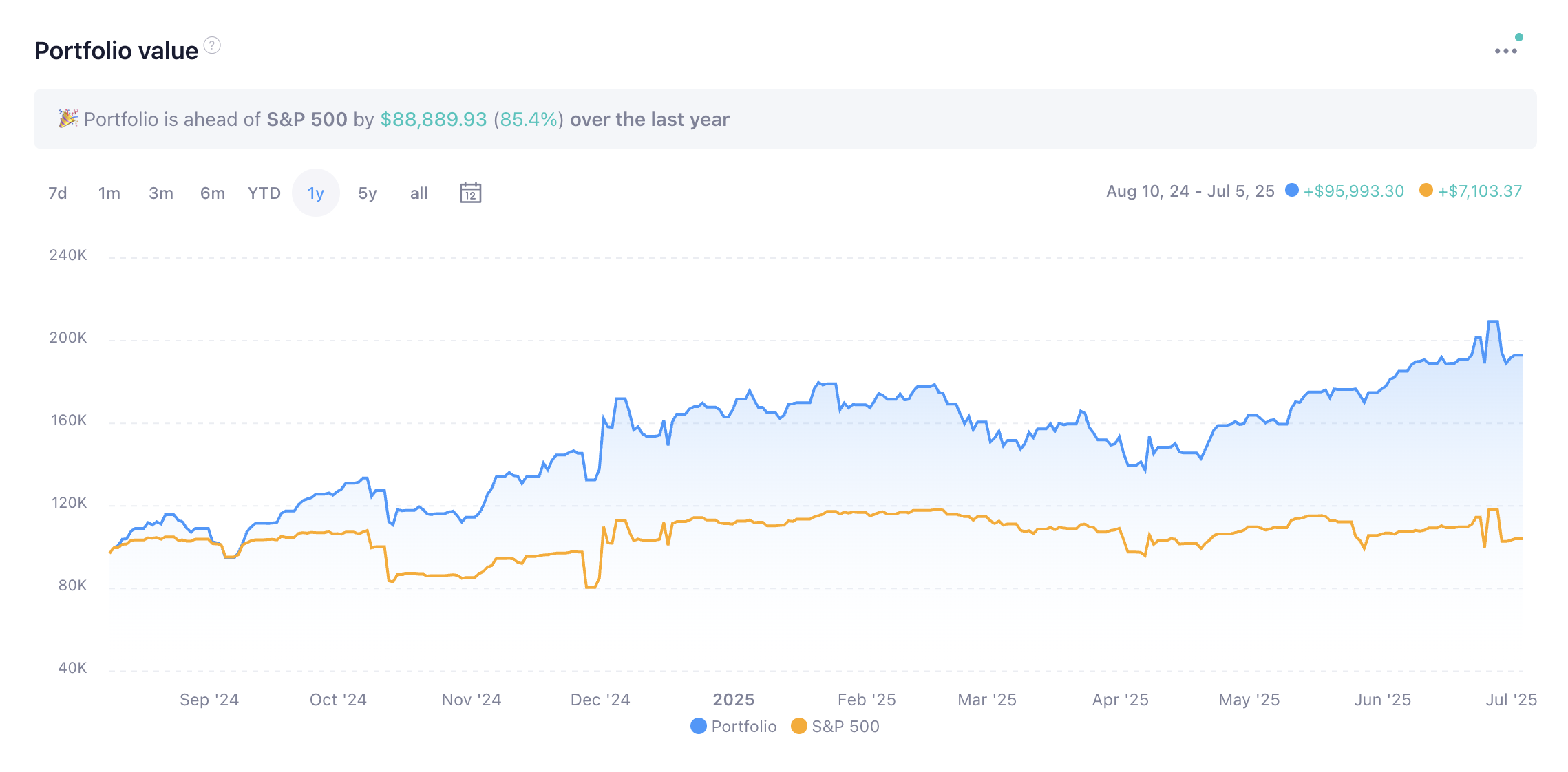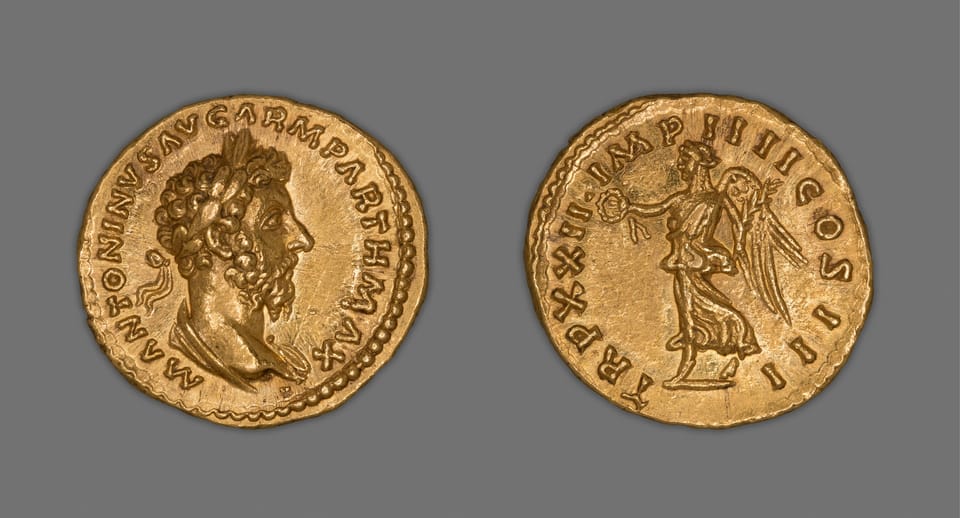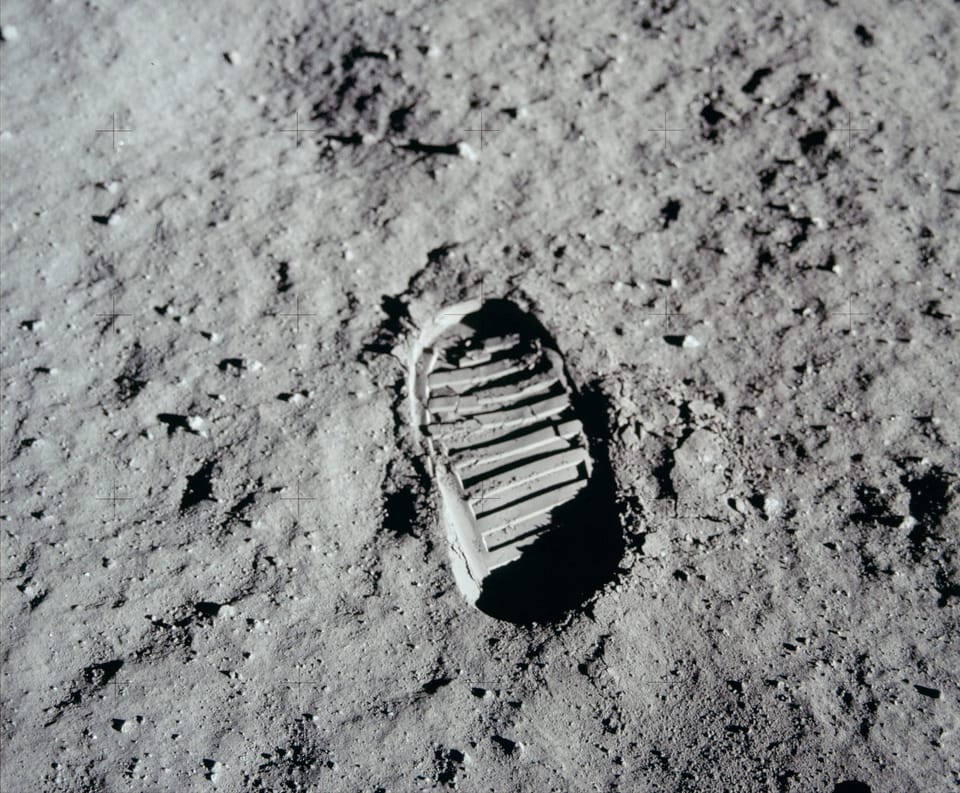Portfolio Update: Is This The Peak (For Now)?
Since its inception in August 2024, the I&F Portfolio has gained over 100%, outpacing the S&P 500 by 85%, driven by standout performances from Rocket Lab (RKLB), Verona Pharma (VRNA), Navitas Semiconductor (NVTS), and others.

This is not financial advice and is for entertainment purposes only. Do your own due diligence. The author hold or did hold a beneficial long position in all companies mentioned. All stock price gains/losses are as of July 3, 2025 after market close. The author receives no compensation for writing this article and has no business relationship with any of the companies mentioned.
It has been almost seven months since I wrote the last update of the Innovation & Freedom Portfolio (external link: Snowball Analytics) and nearly a year since I incepted it in August 2024 (read the inception article here). The mission remains unchanged: to beat the Street by selecting stocks that focus on the innovative power of capitalism and freedom. Thus far, the I&F Portfolio has increased by over 100% and outperformed the S&P 500 by 85%. I will not mention the stocks that I bought and sold during these seven months and no longer hold — everyone makes mistakes. You can find an overview of all transactions here (external link: Snowball Analytics).

I am not very optimistic about the near future. In fact, I think the recent rally might be the greatest bull trap of all time. However, exiting the stock market goes against the idea behind the I&F stock portfolio, which focuses on stock picking rather than market timing. Even if this is only a temporary peak, I am betting on innovation and freedom in the long term.
What I added to the I&F Portfolio
On December 19, 2024, I bought Micron Technology (MU) as my preferred play on the memory supercycle driven by AI servers. Micron was the first to ship 24 Gb HBM3E for Nvidia's B100 accelerators, and it is increasing production of its 1-beta DRAM node. Industry supply discipline and soaring AI demand are restoring pricing power to sellers. Its 232-layer NAND chips are widening the cost gap with rivals, setting the stage for margin expansion as PC and handset inventories normalize. The Boise mega-fab, backed by the CHIPS Act, will anchor long-term U.S. capacity while unlocking roughly $6 billion in government incentives. With the memory cycle improving, it seems that Micron's earnings swing is only halfway priced in. My shares have gone up 23% but still trade at barely 12 times mid-cycle earnings per share (EPS).
On February 3, I added Nebius Group (NBIS) as a conviction play on the surging need for purpose-built AI cloud infrastructure. The company is rolling out large-scale GPU clusters and a full software stack, providing developers with a European, vertically integrated alternative to U.S. hyperscalers. Nvidia's strategic investment in December 2024 underscores the technical credibility of this approach. Although the company is currently operating at a loss, first-quarter revenue increased 385% year-over-year as new capacity came online, signaling significant operating leverage as the company scales. The market has taken notice—my position is already up 63%.
On May 30, I added Frequency Electronics (FEIM) as a timely bet on the rising strategic value of ultra-precise timing hardware for space and defense. In March, the company secured a $12 million increase to its airborne time-and-frequency distribution system contract, highlighting demand for its products in high-dynamic military avionics. Days later, Northrop Grumman honored Frequency Electronics with a Supplier Excellence Award, recognizing its reputation as a mission-critical partner. Then, Frequency Electronics landed a subcontract with Leidos to co-develop a quantum nitrogen-vacancy diamond magnetometer for the Pentagon's MagNav program—an entrée into next-generation quantum sensing. Finally, its inclusion in the Russell 2000 and 3000 indexes adds a liquidity catalyst that should increase institutional ownership (+10%).
On May 30, I also added MIND Technology (MIND) as a contrarian bet, assuming that the increase in offshore energy spending and the new wave of naval modernization would be reflected in this pure-play sonar-and-seismic company's numbers. Ten days later, Seamap, MIND's subsidiary, secured a $4 million order for GunLink source controllers from Sanco Holdings in Norway, ensuring high-margin work for delivery this year and proving my thesis. A week after that, Seamap partnered with GWL Overseas to commercialize the autonomous "Floatseis" nodal seismic system, opening a new lane in next-generation marine data acquisition. Although part shortages reduced Q1 FY-2026 revenue to $7.9 million and delayed $5.5 million in shipments, the backlog has grown to approximately $21 million — its highest level in years — and management expects to turn a profit in Q2. With zero debt and a cash cushion, MIND is well-positioned to weather the backlog conversion. The market is starting to price in the turnaround. My position is already up 32%. To complement my MIND position, I purchased Kraken Robotics (KRKNF) on June 20—another pure play on the revival of subsea sensing with a faster-growing mix of synthetic-aperture sonar, "robotics as a service," and SeaPower batteries. Management just reaffirmed 2025 guidance for 40% top-line growth, and the company has already booked an additional $34 million in battery orders. A $100 million bought-deal financing provides the necessary capital to fulfill the order pipeline (+8%).
After traveling to Singapore and Bali, I added Grab Holdings (GRAB) on June 13th. Having seen firsthand that the region now runs on Grab—with rides, groceries, and even pharmaceuticals flowing through a single super-app—I was convinced. The idea is that this everyday dominance is finally translating into concrete results. Grab posted a GAAP net profit of $10 million in Q1 of 2025, its first, and recorded a record $106 million in adjusted EBITDA, marking its thirteenth consecutive quarterly improvement. Building on this inflection in cash flow, Grab is deepening its competitive advantage through fintech. Deposits at its GXS (Singapore) and GXBank (Malaysia) digital banks have jumped to roughly $1.4 billion, locking users into the Grab ecosystem by providing low-cost funding. Management is signaling confidence with a $500 million share buyback and expects another 40–50% increase in EBITDA in 2025 (+6%).
On June 24, I added Himax Technologies (HIMX) as a quiet-value way to capitalize on two long-term trends: the increase in automotive OLED/TDDI displays and the upcoming surge in lightweight AR glasses. Himax's Q1 2025 results surpassed EPS expectations and maintained a gross margin above 30%, despite a seasonal dip in revenue. Management anticipates resuming sequential growth as supply constraints ease. At Display Week 2025, Himax unveiled a co-designed 350-nit, dual-edge, front-lit LCoS microdisplay with Vuzix — an ultra-bright engine built for mass-market AR eyewear. In the automotive sector, new design wins in electric SUVs are beginning to offset the decline in the smartphone market and are expected to increase the demand for higher-margin TDDI chips through 2026 (+2%).
On June 27, I added Alphabet (GOOG, GOOGL) to the portfolio, which is arguably the cheapest way to own foundational AI technology on a large scale. Although ongoing U.S. and EU monopoly cases create a headwind for investor sentiment, they also underscore the continued dominance of Google Search. Google Search captures about 90% of global queries. This share dipped slightly below 90% for the first time since 2015 in late 2024, according to Statista, Search Engine Land, and other sources. Google is now layering Gemini-powered results without negatively impacting ad click-through rates. Cloud growth is accelerating again, with a 30% increase in Q4 of 2024, supported by AI infrastructure investments, as announced by Alphabet in their fourth quarter and fiscal year 2024 report. Meanwhile, Waymo has quietly logged over 33 million fully autonomous miles, giving the stock a free call option on robotaxi economics. With a forward earnings multiple of about 19x, Alphabet appears to be a value play in disguise. The market has only begun to take notice (+1%).
What I have held since December
Since my last portfolio update, I have published detailed articles here explaining my bullish theses on Hermès (HESAY), Powell Industries' (POWL), and Journey Medical (DERM), which have seen gains of +24%, +23%, and +57%, respectively. My reasons for holding them remain unchanged.
I still hold Fortress Biotech (FBIO), which owns approximately 43% of Journey Medical as of May 31, 2025 (+11%). Meanwhile, Fortress Biotech's other spinoff, Checkpoint Therapeutics (CKPT), was acquired by the Indian pharmaceutical company Sun Pharma. I exited my position in CKPT on May 29, realizing a +29% gain. I continue to hold Verona Pharma (VRNA) because I believe that ensifentrine has blockbuster potential for treating COPD (+304%).
Rocket Lab (RKLB) remains a standout in the I&F portfolio. The company is advancing toward first test flights of its Neutron rocket in 2025. The company is poised to capitalize on surging demand for launch capacity; however, the stock still carries binary risk tied to Neutron’s success. I remain optimistic about Rocket Lab and admire CEO Sir Peter Beck’s engineering vision (+440%).
I continue to hold Navitas Semiconductor (NVTS) even after the impressive rally, as the fundamental thesis for gallium nitride (GaN) semiconductors has only strengthened amid the surge in demand for AI infrastructure. The explosive growth in data center power requirements, fueled by GPU clusters and AI training workloads, creates an urgent need for efficient power management solutions, which GaN technology provides. Navitas’ recent partnership with Nvidia further highlights this momentum by aligning its GaN solutions with cutting-edge AI hardware. Although the stock has performed well since my initial purchase, the addressable market opportunity is still in its early stages, as hyperscalers such as Microsoft, Google, and Amazon are increasingly prioritizing power efficiency to manage their substantial energy costs. Navitas is well-positioned to capture this expanding market as GaN adoption accelerates beyond consumer electronics into high-power-density applications that will define the next generation of computing infrastructure (+205%).
NVIDIA (NVDA) remains at the heart of the current AI revolution. Despite the DeepSeek frenzy, I did not sell. In two articles in January, I explained why DeepSeek's efficiency could be bullish for NVIDIA and why there was no reason to panic. However, after the recent rally, I reduced my holdings and took some profits because I see Nvidia as being priced for perfection again (+40%).
I continue to hold ASML because Washington’s bipartisan reshoring efforts could provide powerful momentum. Trump’s focus on reshoring manufacturing has reignited momentum for U.S. chip manufacturing, building on the subsidies already in place from the CHIPS Act. TSMC, Intel, and Samsung are moving forward with large-scale American fabrication plants, all of which rely on ASML’s indispensable EUV scanners. The need for national security and supply-chain resilience points to a multi-year boom in capital expenditures, positioning ASML as a potential winner in the picks-and-shovels sector (+16%).
I still hold ARS Pharmaceuticals (formerly Silverback Therapeutics, Inc., SPRY) because I am optimistic about the potential of its epinephrine nasal spray, Neffy®, for treating anaphylaxis. The FDA approved Neffy® in August 2024 (+32%).
Despite RFK Jr.’s confirmation as Health Secretary, I continue to hold Moderna (MRNA) because the company’s role goes far beyond traditional vaccines. However, his anti-vaccine views and the recent cancellation of a $766 million bird flu vaccine contract create regulatory uncertainty. I see Moderna as a critical hedge against pandemic threats, such as avian influenza H5N1. Moderna’s technology could produce vaccines within weeks of identifying a viral genome. This makes Moderna indispensable if avian flu evolves to human-to-human transmission. Furthermore, Moderna’s mRNA platform is a vital biodefense asset capable of countering engineered pathogens or bioweapons. This advantage transcends political shifts and reinforces Moderna’s essential role in national security (-12%).
I continue to hold Ryohin Keikaku (RYKKY) because the fundamentals behind my original thesis have only grown stronger. Japan’s tourism boom is fueling global exposure for Muji, turning visitors into brand ambassadors. Significant price gaps between domestic and overseas markets offer margin upside as Muji refines its global pricing. Meanwhile, Muji’s minimalist ethos has shifted from niche to mainstream, especially among younger consumers valuing sustainability and function. Its expansion into home goods, furniture, and lifestyle products is transforming it into a full lifestyle brand, boosting revenue diversity and customer loyalty beyond fashion (+131%).
I continue to hold Northrop Grumman (NOC), the maker of the B21 Raider, as a hedge against tensions in the Pacific (+2%). Kratos Defense (KTOS) remains a top defense pick for me because of its low-cost Valkyrie AI drone (+126%). RTX's missile defense systems are essential to NATO's defense (+25%).
I also continue to hold Salesforce (CRM) because I see potential in AgentForce. AgentForce could significantly reduce the sales force's workload for corporate customers (+7%).
What I removed from the I&F Portfolio
Removing Sagimet Biosciences (SGMT) from my portfolio was probably the biggest mistake I've made so far. The stock has performed incredibly well since I sold it with a loss of 21%. I took my profit and sold AppLovin (APP), yielding in a 381% return. I also sold Modine Manufacturing's (MOD), PagerDuty (PD), Whirlpool Corporation (WHR) and Esperion Therapeutics (ESPR). It may sound paradoxical, but the progress that AI has made in computer programming has made me less confident in software picks such as Docusign (DOCU) and GitLab (GTLB). For this reason, I sold these stocks as well. Lastly, I sold Esperion Therapeutics (ESPR) with a loss of 43%. While Esperion's cholesterol-lowering bempedoic acid has huge potential, I doubt the company's ability to execute and monetize this drug.
Follow me on X for frequent updates (@chaotropy).




